Entries tagged as hardware
Related tags
3d camera flash game headset history mobile mobile phone software technology tracking virtual reality web wiki www 3d printing 3d scanner crowd-sourcing diy evolution facial copy food innovation&society medecin microsoft physical computing piracy programming rapid prototyping recycling robot virus ad android ai algorythm apple arduino automation data mining data visualisation network neural network sensors siri amd cpu intel qualcomm app google htc ios linux os sdk super collider tablet usb api facial recognition glass interface mirror amazon cloud iphone ar augmented reality satellite army drone artificial intelligence big data car cloud computing privacy program super computer asus kinect light wifi chrome browser firefox ie laptop computing farm open source security sustainabilityThursday, September 22. 2011
Dr. Watson - Come Here - I Need You
Via big think
By Dominic Basulto
-----

The next time you go to the doctor, you may be dealing with a supercomputer rather than a human. Watson, the groundbreaking artificial intelligence machine from IBM that took on chess champions and Jeopardy! contestants alike, is about to get its first real-world application in the healthcare sector. In partnership with health benefits company WellPoint, Watson will soon be diagnosing medical cases – and not just the everyday cases, either. The vision is for Watson to be working hand-in-surgical-glove with oncologists to diagnose and treat cancer in patients.
The WellPoint clinical trial, which could roll out as early as 2012, is
exciting proof that supercomputing intelligence, when properly
harnessed, can lead to revolutionary breakthroughs in complex fields
like medicine. At a time when talk about reforming the healthcare system
is primarily about the creation of digital health records, the
integration of Watson into the healthcare industry could really shake
things up. By some accounts, Watson
is able to process as many as 200 million pages of medical information
in seconds – giving it a number-crunching head start on doctors for
diagnosing cases. In one test case cited by WellPoint, Watson was able
to diagnose a rare form of an illness within seconds – a case that had
left doctors baffled.
While having super-knowledgeable medical experts on call is exciting, it also raises several thorny issues. At what point – if ever - would you ask for a “second opinion” on your medical condition from a human doctor? Will “Watson” ever be included in the names of physicians included in your HMO listings? And, perhaps most importantly, can supercomputers ever provide the type of bedside manner that we are accustomed to in our human doctors?
This last question has attracted much attention from medical practitioners and health industry thought leaders alike. Abraham Verghese,
a professor at the Stanford University School of Medicine as well as
bestselling author, has been particularly outspoken about the inability
of computers to provide the type of medical handholding that we are used to from human doctors.
Verghese claims that the steady digitization of records and clinical
data is reducing every patient to an "iPatient" – simply a set of
digital 1’s and 0’s that can be calculated, crunched, and computed.
Forget whether androids dream of digital sheep – can they take a digital Hippocratic Oath?
Given that the cost of healthcare is simply too high, as a society we will need to accept some compromises. Once the healthcare industry is fully digitized, supercomputers like Watson could result in a more cost-effective way to sift through the ever-growing amount of medical information and provide real-time medical analysis that could save lives. If Watson also results in a significant improvement in patient treatment as well, it’s clear that the world of medicine will never be the same again. Right now, IBM envisions Watson supplementing – not actually replacing - doctors. But the time is coming when nurses across the nation will be saying, “Watson -- Come Here –- I Need You,” instead of turning to doctors whenever they need a sophisticated medical evaluation of a patient.
Monday, September 19. 2011
UNIVAC: the troubled life of America's first computer
Via ars technica
By Matthew Lasar
-----
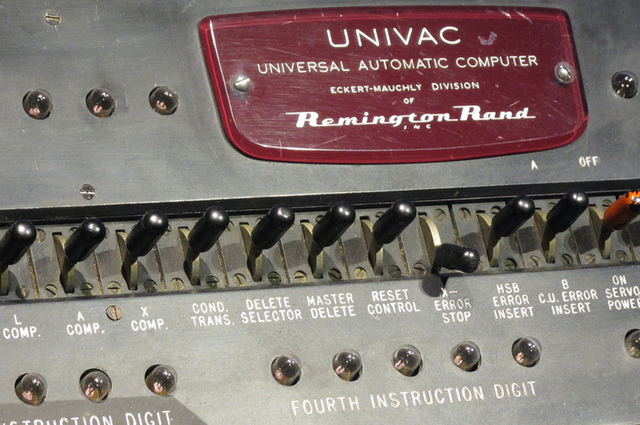
It was November 4, 1952, and Americans huddled in their living rooms to follow the results of the Presidential race between General Dwight David Eisenhower and Adlai Stevenson, Governor of Illinois. We like to think that our time is a unique moment of technological change. But the consumers observing this election represented an unprecedented generation of early adopters, who watched rather than listened to the race on the radio. By that year they had bought and installed in their homes about 21 million copies of a device called the television—about seven times the number that existed just three years earlier.
On that night they witnessed the birth of an even newer technology—a machine that could predict the election's results. Sitting next to the desk of CBS Anchor Walter Cronkite was a mockup of a huge gadget called a UNIVAC (UNIVersal Automatic Computer), which Cronkite explained would augur the contest. J. Presper Eckert, the UNIVAC's inventor, stood next to the device and explained its workings. The woman who actually programmed the mainframe, Navy mathematician Grace Murray Hopper was nowhere to be seen; for days her team had input voting statistics from earlier elections, then wrote the code that would allow the calculator to extrapolate the contest based on previous races.
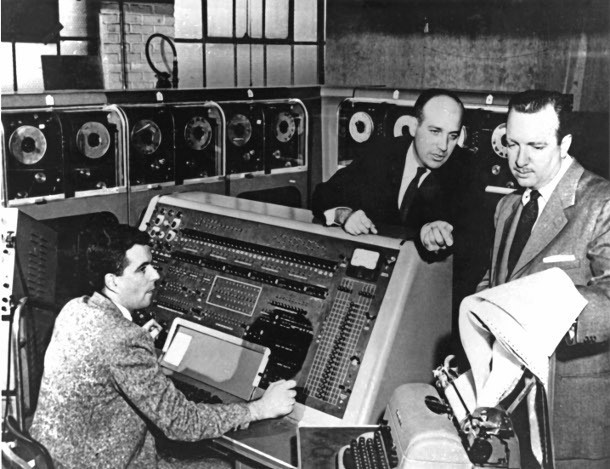
J. Presper Eckert and CBS's Walter Cronkite pondering the UNIVAC on election night, 1952.
To the disquietude of national pollsters expecting a Stevenson victory, Hopper's UNIVAC group predicted a huge landslide for Eisenhower, and with only five percent of the results. CBS executives didn't know what to make of this bold finding. "We saw [UNIVAC] as an added feature to our coverage that could be very interesting in the future," Cronkite later recalled. "But I don't think that we felt the computer would become predominant in our coverage in any way."
And so CBS told its audience that UNIVAC only foresaw a close race. At the end of the evening, when it was clear that UNIVAC's actual findings were spot on, a spokesperson for the company that made the machine was allowed to disclose the truth—that the real prediction had been squelched.
"The uncanny accuracy of UNIVAC's prediction during a major televised event sent shock waves across through the nation," notes historian Kurt W. Beyer, author of Grace Hopper and the Invention of the Information Age. "In the months that followed, 'UNIVAC' gradually became the generic term for a computer."
That's putting it mildly. By the late 1950s the UNIVAC and its cousin, the ENIAC, had inspired a generic sobriquet for anyone with computational prowess—a "BRAINIAC." The term became so embedded in American culture that to this day your typical computer literacy quiz includes the following multiple choice poser:
Which was not an early mainframe computer?
- ENIAC
- UNIVAC
- BRAINIAC
But the fact that this question is even posed is testimony to the other key component of UNIVAC's history—its famous trajectory was cut short by a corporation with a much larger shadow: IBM. The turbulent life of UNIVAC offers interesting lessons for developers and entrepreneurs in our time.
The machines and their teams
During the Second World War, two teams in the United States were deployed to improve the calculations necessary for artillery firing and strategic bombing. Hopper worked with Harvard mathematician Howard Aiken, whose Mark I computer performed computations for the Navy. John Mauchly and J. Presper Eckert's Electronic and Numerical Integrator and Computer (ENIAC) rolled out rocket firing tables for the Army.
While both groups served extraordinarily during the war, their leaders could not have thought about these devices more differently. Aiken viewed them as scientific tools. Mauchly saw their potential as commercial instruments.
After the conflict, Aiken obstinately lobbied against the commercialization of computing, inveighing against the "foolishness with Eckert and Mauchly," at computer conferences. Perhaps there was a need for five or six machines in the country, he told associates; no more. But Aiken's assistant Hopper was fascinated by the duo—the former a graduate student and the latter a professor of electronics.
Eckert was "looking way ahead," Hopper recalled. "Even though he was a college professor he was visualizing the use of these computers in the business and industrial area." The University of Pennsylvania sided with Aiken. The college offered Eckert and Mauchly tenured positions, but only on the condition that they sign patent releases for all their work. Both inventors resigned from the campus and in the spring of 1946 formed the Electronic Control Company, which eventually became the Eckert-Mauchly Computer Corporation.
Over the course of five years, the two developers rethought everything associated with computational machines. The result was a device that went way beyond the age of punch card calculators associated with IBM devices. The UNIVAC, unveiled in 1951, was the fruit of this effort.
"No one who saw a UNIVAC failed to see how much it differed from existing calculators and punched card equipment," writes historian Paul E. Ceruzzi:
It used vacuum tubes—thousands of them. It stored data on tape, not cards. It was a large and expensive system, not a collection of different devices. The biggest difference was its internal design, not visible to the casual observer. The UNIVAC was a "stored program" computer, one of the first. More than anything else, that made it different from the machines it was designed to replace.
These characteristics would enable the UNIVAC to perform thousands more operations per second than its closest rival, the Harvard Mark II. And its adaptation of the entertainment industry's new tool—magnetic recording tape—would allow it to store vastly more data. UNIVAC was quickly picked up by the US Census Bureau in a $300,000 contract, which was followed by another deal via the National Bureau of Standards. Soon a racetrack betting odds calculator company called American Totalisator signed on, purchasing a 40 percent interest in the company.
You could see and hold it
But Eckert-Mauchly could not handle this volume of work on its own. Its principals drastically underbid on key contracts. After a plane crash killed the corporation's board president, the inventors and Totalisor clashed over the viability of the project. The duo then went to IBM for backing and met with Thomas Watson Junior and Senior, but could not convince the elder executive of the UNIVAC's viability.
"Having built his career on punch cards," Watson Jr. later reflected, "Dad distrusted magnetic tape instinctively. On a punch card, you had a piece of information that was permanent. You could see it and hold it in your hand.... But with magnetic tape, your data were stored invisibly on a medium that was designed to be erased and reused."
So EMCC turned to its second choice—the Remington Rand office equipment company, whose founder James Rand expressed outrage when he saw a reworked IBM typewriter rather than a Remington hooked up to the UNIVAC. "Take that label off that machine!" Rand declared on his first visit to an EMCC laboratory. "I don't want it seen in here!"
The tenderness over an IBM logo aside, Remington Rand brought an important innovation to the UNIVAC—television advertisements. The longer infomercials came complete with symphony orchestra introductions and historical progress timelines that began with the Egyptian Sphinx. The shorter ones extolled the role that UNIVAC was playing in weather prediction. "Today UNIVAC is saving time and increasing efficiency for science, industry, business, and government," one ad concluded.
A Remington Rand UNIVAC commercial.
But while that was certainly true about what the machine did for its clients, historian Beyer notes that it didn't extend to Remington's management of EMCC. Most of the office company's top staff, like its founder, didn't understand the device, and related more to punch card machines. The man put in direct charge of EMCC, former Manhattan Project director Leslie Groves, tossed Mauchly to the sales department when he flunked a company security clearance test (apparently he had attended some Communist Party meetings in the 1930s).
On top of that, new management did not sympathize with EMCC's female programmers, among them Grace Hopper, who by 1952 had written the UNIVAC's first software compiler. "There were not the same opportunities for women in larger corporations like Remington Rand," she later reflected. "They were older companies, and the jobs had been stereotyped."
Then there was Groves' marketing strategy for the UNIVAC, which amounted to selling less of the devices, even as they were being hawked on TV as exemplars of technological progress. He ordered a fifty percent annual production quota drop. "With such low sales expectations, there was little incentive to educate Remington Rand's sizeable sales force about the new technology," Beyer explains.
The biggest blow, however, came when IBM began to rethink its aversion to magnetic mainframe storage.
Left in the dust
Despite Remington/EMCC's internal chaos, interest in the UNIVAC exploded after the 1952 CBS demonstration. This created more problems. Hopper's programming staff was now besieged with attractive offers from companies using IBM gear, creating a brainiac drain within EMCC itself. "Some members of Dr. Grace Hopper's staff have already left for positions with users of IBM equipment," Mauchly noted in a memo, "and those of her staff who still remain are now expecting attractive offers from outside sources."
Customer service and support became more and more of a challenge. Still, the UNIVAC was highly competitive with IBM equipment. The question was whether EMCC could beat Big Blue in government contract bidding, specifically for the Semi-Automatic Ground Environment (SAGE) defense communications network.
The SAGE project amounted to an early-warning radar system designed to pick up enemy bomber activity around the nation's borders. It was the brainchild of Jay Forrester, director of MIT's Sernomechanisms Laboratory, and central to the idea was a network of digital computers to integrate the network, dubbed "Project Whirlwind." In three years Forrester's team had pioneered real-time, high-capacity access memory for the mainframes. The government now offered a contract to build 50 Whirlwind computers. IBM quickly rallied its forces for the contest.
"I thought it was absolutely essential to IBM's future that we win it," Thomas Watson Jr., who had none of Senior's allergies to digital computing, later explained. "The company that built those computers was going to be way ahead of the game, because it would learn the secrets of mass production."
Forrester gave the matter some thought. Remington Rand had UNIVAC. And it had the prestige of Manhattan Project Director Leslie Groves. But Remington did not have IBM's scale of operation or its production capacity. Indeed, under Groves' direction, it had scaled that capacity down. In 1953, the government offered the contract to IBM. Historian Beyer explains the consequences of this decision:
Not only did IBM take away knowledge about random-access magnetic core memory; they also learned how the Whirlwind team had pushed the technological envelope in a number of other areas. Forrester's staff had figured out a variety of ways to lower the frequency of vacuum-tube failure, thus increasing system reliability. Cathode-ray-tube displays were ingeniously employed to display processed information, index registers made programming easier, and real-time information from radar sensors could be processed without the need for a slow input medium such as punch cards.
IBM quickly integrated these discoveries into its next rollout of commercial computers. The market loved them and ordered thousands. "In a little over a year we started delivering those redesigned computers," Watson Jr. later boasted. "They made the UNIVAC obsolete and we soon left Remington Rand in the dust."
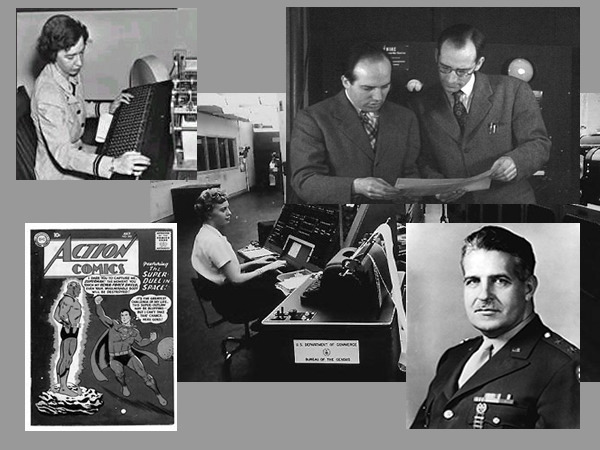
The UNIVAC universe of the 1950s—clockwise from top left: UNIVAC mathematician and programmer Grace Hopper; John W. Mauchly and John Presper Eckert; General Leslie Groves of Remington Rand; DC Comics' Brainiac confronting Superman in 1959; a Department of Commerce UNIVAC in the center.
Aftermath
Sensing the dust around it, in 1955 Remington merged with the Sperry Corporation and became Sperry Rand. No less than General Douglas MacArthur ran the new entity. This gave the UNIVAC a new lease on digital life, but one that operated in the shadow of the company that had once sworn that it would stick to punch tape: IBM.
In the meantime, a slew of firms jumped into the high-speed computing business, among them RCA, National Cash Register, General Electric, and Honeywell. "IBM and the Seven Dwarfs," they were dubbed. UNIVAC was now a dwarf.
Grace Hopper continued her work. She became an advocate of the assumption inherent in her UNIVAC compiler which she called "automatic" computing—the notion that programs should emphasize simple English words. Her compiler, later called FLOW-MATIC, understood 20 words.
Her contemporaries patiently informed her that this number was enough. Hopper "was told very quickly that [she] couldn't do this because computers didn't understand English," she later noted. Happily, she did not believe this to be true, and advised a team that developed the COBOL programming language, which she championed and furthered through the 1960s and 1970s. US Navy Rear-Admiral Grace Murray Hopper died in 1992.
Having fattened IBM on government grants for decades, the Department of Justice launched an antitrust suit against the corporation in 1969. This initiative was suddenly withdrawn by the Reagan administration in 1982—as the company once again jolted the industry by jumping into the PC market.
As for UNIVAC, its complex birth 60 years ago remains the moment when we discovered that computers were going to be part of our lives—that they were going to become integral our work and collective imagination. It was also a moment when information systems developers and entrepreneurs learned that innovation and genius are not always a match for influence and organizational scale.
"Howard Aiken was wrong," historian Paul Cerruzi wrote in 2000. "There turned out to be a market for millions of electronic digital computers by the 1990s." Their emergence awaited advances in solid state physics. Nonetheless, "the nearly ubiquitous computers of the 1990s are direct descendants of what Eckert and Mauchly hoped to commercialize in the late 1940s."
Further reading
Most of the material in this essay comes from Kurt W. Beyer's must-read book, Grace Hopper and the Invention of the Information Age (MIT Press). Also essential is Paul E. Ceruzzi's History of Modern Computing.
Tuesday, September 06. 2011
Modular’ 3D Printed Shoes by Objet on Display at London’s Victoria and Albert Museum
Via object
-----

Marloes ten Bhromer is a critically acclaimed Dutch designer. She produces some incredible outworldly shoe designs based on a unique combination of art and technological functionality.
One of her most exciting new designs is called the 'Rapidprototypedshoe' – created on the Objet Connex multi-material 3D printer.
Why did she use rapid prototyping? According to Marloes, this is because; "rapid prototyping – adding material in layers – rather than traditional shoe manufacturing methods – could help me create something entirely new within just a few hours."
And why Objet? Again, in her words; "Objet Connex printers make it possible to print an entire shoe – albeit a concept shoe – including a hard heel and a flexible upper in one build, which just isn't possible with other 3D printing technologies."
The Objet Connex multi-material 3D printer allows the simulatneous printing of both rigid and rubber-like material grades and shades within a single prototype, which is why it's used by many of the world's largest shoe manufacturers. And of course, because it's 3D printing and not traditional manufacturing methods, there are no expensive set-up costs and no minimum quantities to worry about!
This particular shoe design is based on a modular concept – with an interchangeable heel to allow for specific customizations as well as easy repairs (see the bottom photo which shows the heel detatched).
 The 3D printed modular shoe will be available for viewing at the Power of Making exhibition – starting today at the world-famous Victoria and Albert Museum in London. If you are anywhere near the UK this is worth a visit.
The 3D printed modular shoe will be available for viewing at the Power of Making exhibition – starting today at the world-famous Victoria and Albert Museum in London. If you are anywhere near the UK this is worth a visit.
If you can't make it right at this moment, don't worry – the shoe and the exhibit will remain there until January 2nd.
The Power of Making exhibition is created in collaboration with the Crafts Council. Curator Daniel Charney's aim is to encourage visitors to consider the process of making, not just the final results. For this the 3D printing process is particularly salient.
For more details on this story read the Press Release here.
-----
See also the first 'printed' plane
Thursday, September 01. 2011
Raspberry Pi $25 Computer Running Quake III
Via TechCrunch
-----
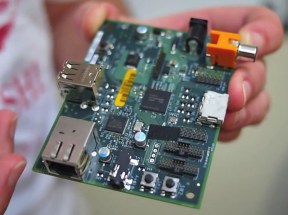
You may recall the Raspberry Pi, a barebones PC for emerging markets that they hope to sell for $25. When we wrote it up earlier this year, there wasn’t much in the way of demonstration: a few stills of the PCB and a video with founder David Braben describing his plan for the device. But today we have a demo that both captures the geek imagination and proves the device has legs:they’ve got it running Quake III.
Not that it’s some big accomplishment to run a game released in the last millennium, but it actually does pretty well. The device uses a 700MHz ARM processor and has 128MB of RAM enabled here, and lacking any on-device storage, it’s running the OS (Debian CLI) and the game off an SD card.
They could hit higher framerates, but wanted to show that 1920×1080 with 4xAA was possible. Naturally you could reduce this quite a bit and max out the refresh rate on your monitor; Q3A isn’t exactly the most graphics-intensive game on the market.
The game isn’t being emulated; they actually compiled the open source version for their Debian build. They plan on networking a few together and playing a deathmatch soon.
Now, the point of this isn’t that now, impoverished children in Kazakhstan will be able to hone their all-important FPSing skills. It’s more of a proof of concept showing that a (fairly) modern piece of software can be adapted to the hardware they’ve put together: the Raspberry Pi really is a full-on computer. And while there are Micro ATX boards and systems out there (very useful ones in fact), they don’t come anywhere near the $25 mark. You still need an LCD, keyboard, SD card or USB drive, and so on, but the Raspberry Pi Foundation is all about lowering the entry barrier and providing everything that’s needed in a basic computer for as low a price as possible.
Keep up with the project here. They’ve still got a lot of work to do before they make this a viable product, but things seem to be moving along rapidly.
Friday, August 26. 2011
MicroGen Chips to Power Wireless Sensors Through Environmental Vibrations
Via Daily Tech
-----
MicroGen Systems says its chips differ from other vibrational energy-harvesting devices because they have low manufacturing costs and use nontoxic material instead of PZT, which contains lead.
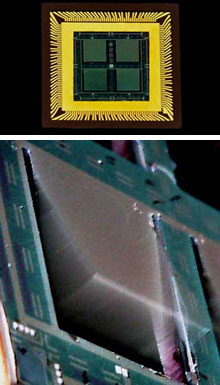
(TOP) Prototype wireless sensor battery with four energy-scavenging chips. (BOTTOM) One chip with a vibrating cantilever (Source: MicroGen Systems )
MicroGen
Systems is in the midst of creating energy-scavenging chips that will convert
environmental vibrations into electricity to power wireless sensors.
The
chip's core consists of an array of small silicon cantilevers that
measure one centimeter squared and are located on a
"postage-stamp-sized" thin film battery. These cantilevers oscillate
when the chip is shook, and at their base is piezoelectric material that produces electrical potential when strained by
vibrations.
The current travels from the piezoelectric array through an electrical device
that converts it to a compatible form for the battery. When jostling the chip
by vibrations of a rotating tire, for example, it can generate 200 microwatts
of power.
Critics such as David Culler, chair of computer science at the University of
California, have said that 200 microwatts may be useful at a small size, but
other harvesting techniques through solar, light, heat, etc. are
more competitive technologies since they can either store the electrical energy
on a battery or use it right away.
But according to Robert Andosca, founder and president of Ithaca, New
York-based MicroGen Systems, his chips differ from other vibrational
energy-harvesting devices because they have low manufacturing costs and use
nontoxic material instead of PZT, which contains lead.
Most piezoelectric materials must be assembled by hand and can be quite large.
But MicroGen's chips can be made inexpensively and small because they are based
on silicon microelectrical mechanical systems. The chips can be made on the
same machines used to make computer chips.
MicroGen Systems hopes to use these energy-harvesting chips to power wireless sensors like those that
monitor tire pressure. The chips could eliminate the need to replace these
batteries.
"It's a pain in the neck to replace those batteries," said Andosca.
MicroGen Systems plans to sell these chips at $1 a piece, depending on the
volume, and hopes to begin selling them in about a year.
Wednesday, August 03. 2011
WIMM Wearable Platform
Via SlashGear
-----
Wearable sub-displays keep coming around, and WIMM Labs is the latest company to try its hand at the segment. Its WIMM Wearable Platform – a 1.4-inch color touchscreen, scaled to be wearable on your wrist, and paired with WiFi, Bluetooth, various sensors and running Android-based “Micro Apps” – obviously stood out of the crowd, having caught the attention of Foxconn and two rounds of financing from the huge manufacturing/ODM company. We caught up with the WIMM Labs team to check out the Wearable Platform and find out if it stood more chance of success than, say, Sony Ericsson’s LiveView.
The basic premise of the Wearable Platform isn’t new. People carry their phones and tablets in pockets and bags, not in their hand, and so when nuggets of information, alerts and updates come in, they need to be taken out in order to check them. A wearable display – strapped to your wrist, hanging on a lanyard from your belt or bag, or otherwise attached to you – means at-a-glance review, allowing you to decide whether you need to fish out your phone or if it can wait until later.
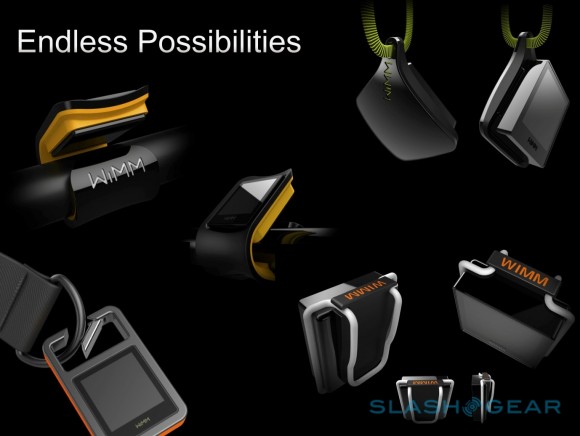
WIMM’s One developer kit hardware is a step ahead of some systems we’ve already seen. The 1.4-inch capacitive touch display operates in dual-modes, either as a regular screen or transflective backlight-free so that it’s still readable (albeit in monochrome) but battery life is extended. This passive display mode works in tandem with a 667MHz Samsung microcontroller, WiFi, Bluetooth, GPS, an accelerometer and a digital compass, all contained in a waterproof casing – made of either plastic or of a new wireless-compatible ceramic – measuring 32 x 36 x 12.5 mm and weighing 22g.
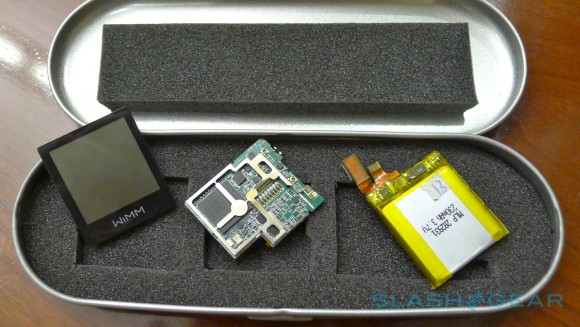
That casing, WIMM says, should be standardized so that each unit – the Wearable Platform will be licensed out to third-party companies – will hopefully be interchangeable with the same mounting pins. That way, if you buy a new model from another firm, it should be able to snap into your existing watch strap. Up to 32GB of memory is supported, and the One can notify you with audio or tactile alerts. Battery life is said to last at least a full day, and it recharges using a magnetic charger (that plugs in via microUSB) or a collapsable desk-stand that adds an integrated battery good for up to four recharge cycles and useful if you’re on the road.
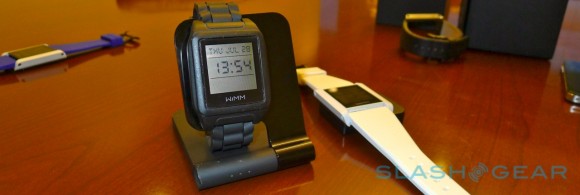
Control is via a series of taps, swipes and physical gestures (the sensors allow the Wearable Platform to react to movement), including a two-finger swipe to pull down the watch face. WIMM will preload a handful of apps – the multifunction clock, a real-time information viewer showing weather, etc, and a cellphone companion which can show incoming caller ID, a preview of new SMS messages, and assist you in finding a lost phone. Pairing can be either via WiFi or Bluetooth, and the micro-display will work with Android, iOS and BlackBerry devices. Apps are selected from a side-scrolling carousel, loaded by flicking them up toward the top of the screen, and closed by flicking them down.
However, the preloaded apps are only to get you interested: the real movement, WIMM expects, is in the Micro App store. The Android-based SDK means there’s few hurdles for existing Android developers to get up to speed, and licensees of the Wearable Platform will be able to roll out their own app stores, based on WIMM’s white label service, picking and choosing which titles they want to include. The company is targeting performance sport and medical applications initially, with potential apps including exercise trackers, heart rate monitors and medication reminder services.
A DIY UAV That Hacks Wi-Fi Networks, Cracks Passwords, and Poses as a Cell Phone Tower
Via POPSCI
By Clay Dillow
-----

Just a Boy and His Cell-Snooping, Password-Cracking, Hacktastic Homemade Spy Drone via Rabbit-Hole
Last year at the Black Hat and Defcon security conferences in Las Vegas, a former Air Force cyber security contractor and a former Air Force engineering systems consultant displayed their 14-pound, six-foot-long unmanned aerial vehicle, WASP (Wireless Aerial Surveillance Platform). Last year it was a work in progress, but next week when they unveil an updated WASP they’ll be showing off a functioning homemade spy drone that can sniff out Wi-Fi networks, autonomously crack passwords, and even eavesdrop on your cell phone calls by posing as a cell tower.
WASP is built from a retired Army target drone, and creators Mike Tassey and Richard Perkins have crammed all kinds of technology aboard, including an HD camera, a small Linux computer packed with a 340-million-word dictionary for brute-forcing passwords as well as other network hacking implements, and eleven different antennae. Oh, and it’s autonomous; it requires human guidance for takeoff and landing, but once airborne WASP can fly a pre-set route, looping around an area looking for poorly defended data.
And on top of that, the duo has taught their WASP a new way to surreptitiously gather intel from the ground: pose as a GSM cell phone tower to trick phones into connecting through WASP rather than their carriers--a trick Tassey and Perkins learned from another security hacker at Defcon last year.
Tassey and Perkins say they built WASP so show just how easy it is, and just how vulnerable you are. “We wanted to bring to light how far the consumer industry has progressed, to the point where public has access to technologies that put companies, and even governments at risk from this new threat vector that they’re not aware of,” Perkins told Forbes.
Consider yourself warned. For details on the WASP design--including pointers on building your own--check out Tassey and Perkins site here.
Monday, August 01. 2011
World's first 'printed' plane snaps together and flies
Via CNET
By Eric Mach
-----
English engineers have produced what is believed to be the world's first printed plane. I'm not talking a nice artsy lithograph of the Wright Bros. first flight. This is a complete, flyable aircraft spit out of a 3D printer.
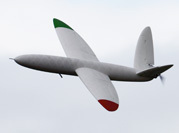
The SULSA began life in something like an inkjet and wound up in the air. (Credit: University of Southhampton)
The SULSA (Southampton University Laser Sintered Aircraft) is an unmanned air vehicle that emerged, layer by layer, from a nylon laser sintering machine that can fabricate plastic or metal objects. In the case of the SULSA, the wings, access hatches, and the rest of the structure of the plane were all printed.
As if that weren't awesome enough, the entire thing snaps together in minutes, no tools or fasteners required. The electric plane has a wingspan of just under 7 feet and a top speed of 100 mph.
Jim Scanlon, one of the project leads at the University of Southhampton, explains in a statement that the technology allows for products to go from conception to reality much quicker and more cheaply.
"The flexibility of the laser-sintering process allows the design team to revisit historical techniques and ideas that would have been prohibitively expensive using conventional manufacturing," Scanlon says. "One of these ideas involves the use of a Geodetic structure... This form of structure is very stiff and lightweight, but very complex. If it was manufactured conventionally it would require a large number of individually tailored parts that would have to be bonded or fastened at great expense."
So apparently when it comes to 3D printing, the sky is no longer the limit. Let's just make sure someone double-checks the toner levels before we start printing the next international space station.
-----
Personal comments:
Industrial production tools back to people?
Fab@Home project
Thursday, July 28. 2011
Decoding DNA With Semiconductors
Via New York Times
By Christopher Capozziello
-----
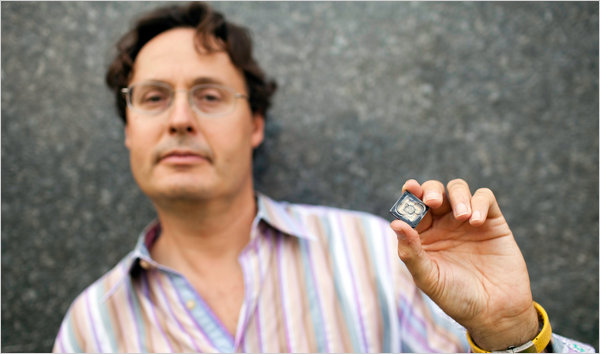
The inventor Jonathan Rothberg with a semiconductor chip used in the Ion Torrent machine.
The inventor of a new machine that decodes DNA with semiconductors has used it to sequence the genome of Gordon Moore, co-founder of Intel, a leading chip maker.
The inventor, Jonathan Rothberg of Ion Torrent Systems in Guilford, Conn., is one of several pursuing the goal of a $1,000 human genome, which he said he could reach by 2013 because his machine is rapidly being improved.
“Gordon Moore worked out all the tricks that gave us modern semiconductors, so he should be the first person to be sequenced on a semiconductor,” Dr. Rothberg said.
At $49,000, the new DNA decoding device is cheaper than its several rivals. Its promise rests on the potential of its novel technology to be improved faster than those of machines based on existing techniques.
Manufacturers are racing to bring DNA sequencing costs down to the point where a human genome can be decoded for $1,000, the sum at which enthusiasts say genome sequencing could become a routine part of medical practice.
But the sequencing of Dr. Moore’s genome also emphasizes how far technology has run ahead of the ability to interpret the information it generates.
Dr. Moore’s genome has a genetic variant that denotes a “56 percent chance of brown eyes,” one that indicates a “typical amount of freckling” and another that confers “moderately higher odds of smelling asparagus in one’s urine,” Dr. Rothberg and his colleagues reported Wednesday in the journal Nature. There are also two genetic variants in Dr. Moore’s genome said to be associated with “increased risk of mental retardation” — a risk evidently never realized. The clinical value of this genomic information would seem to be close to nil.
Dr. Rothberg said he agreed that few genes right now yield useful genetic information and that it will be a 10- to 15-year quest to really understand the human genome. For the moment his machine is specialized for analyzing much smaller amounts of information, like the handful of genes highly active in cancer.
The Ion Torrent machine requires only two hours to sequence DNA, although sample preparation takes longer. The first two genomes of the deadly E. coli bacteria that swept Europe in the spring were decoded on the company’s machines.
The earliest DNA sequencing method depended on radioactivity to mark the four different units that make up genetic material, but as the system was mechanized, engineers switched to fluorescent chemicals. The new device is the first commercial system to decode DNA directly on a semiconductor chip and to work by detecting a voltage change, rather than light.
About 1.2 million miniature wells are etched into the surface of the chip and filled with beads holding the DNA strands to be sequenced. A detector in the floor of the well senses the acidity of the solution in each well, which rises each time a new unit is added to the DNA strands on the bead. The cycle is repeated every few seconds until each unit in the DNA strand has been identified.
Several years ago, Dr. Rothberg invented another DNA sequencing machine, called the 454, which was used to sequence the genome of James Watson, the co-discoverer of the structure of DNA. Dr. Rothberg said he was describing how the machine had “read” Dr. Watson’s DNA to his young son Noah, who asked why he did not invent a machine to read minds.
Dr. Rothberg said he began his research with the idea of making a semiconductor chip that could detect an electrical signal moving across a slice of neural tissue. He then realized the device he had developed was more suited to sequencing DNA.
George Church, a genome technologist at the Harvard Medical School, said he estimated the cost to sequence Dr. Moore’s genome at $2 million. This is an improvement on the $5.7 million it cost in 2008 to sequence Dr. Watson’s genome on the 454 machine, but not nearly as good as the $3,700 spent by Complete Genomics to sequence Dr. Church’s genome and others in 2009.
Dr. Rothberg said he had already reduced the price of his chips to $99 from $250, and today could sequence Dr. Moore’s genome for around $200,000. Because of Moore’s Law — that the number of transistors placeable on a chip doubles about every two years — further reductions in the cost of the DNA sequencing chip are inevitable, Dr. Rothberg said.
Stephan Schuster, a genome biologist at Penn State, said his two Ion Torrent machines were “outstanding,” and enabled a project that would usually have taken two months to be completed in five days.
There is now “a race to the death as to who can sequence faster and cheaper, always with the goal of human resequencing in mind,” Dr. Schuster said.
Monday, July 18. 2011
Chrome OS: The Cloud-Only Problem is Coming Home to Roost
Via OStatic
-----
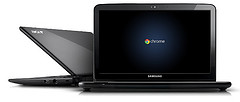 Now
that Chromebooks--portable computers based on Google's Chrome OS--are
out in the wild and hands-on reviews are appearing about them, it's
easier to gauge the prospects for this new breed of operating system.
As Jon Buys discussed here on OStatic,
these portables are not without their strong points. However, there
are criticisms appearing about the devices, and the criticisms echo
ones that we made early on. In short, Chromebooks force a cloud-only
compute model that leaves people used to working with local files and
data in the cold.
Now
that Chromebooks--portable computers based on Google's Chrome OS--are
out in the wild and hands-on reviews are appearing about them, it's
easier to gauge the prospects for this new breed of operating system.
As Jon Buys discussed here on OStatic,
these portables are not without their strong points. However, there
are criticisms appearing about the devices, and the criticisms echo
ones that we made early on. In short, Chromebooks force a cloud-only
compute model that leaves people used to working with local files and
data in the cold.
In his OStatic post on Chromebooks, Jon Buys noted that the devices are "built to be the fastest way to get to the web." Indeed, Chromebooks boot in seconds--partly thanks to a Linux core--and deposit the user into an environment that looks and works like the Chrome browser.
However, Cade Metz, writing for The Register, notes this in a review of the Samsung Chromebook, which is available for under $500:
"Running Google's Chrome OS operating system, Chromebooks seek to move everything you do onto the interwebs. Chrome OS is essentially a modified Linux kernel that runs only one native application: Google's Chrome browser….This also means that most of your data sits on the web, inside services like Google Docs…The rub is that the world isn't quite ready for a machine that doesn't give you access to local files."
That's exactly what I felt woud be the shortcoming of devices based on Chrome OS, as seen in this post:
"With Chrome OS, Google is betting heavily on the idea that consumers and business users will have no problem storing data and using applications in the cloud, without working on the locally stored data/applications model that they're used to. Here at OStatic, we always questioned the aggressively cloud-centric stance that Chrome OS is designed to take. Don't users want local applications too? Why don't I just run Ubuntu and have my optimized mix of cloud and local apps? After all, the team at Canonical, which has a few years more experience than Google does in the operating system business, helped create Chrome OS. "
The interesting thing is, though, that Google may have an opportunity to easily address this perceived shortcoming. For example, Chrome OS now has a file manager, and it's not much of a leap to get from a file manager to a reasonable set of ways to store local data and manage it. Odds are that Google will change the way Chrome OS works going forward, making it less cloud-centric. That would seem to be a practical course of action.
Quicksearch
Popular Entries
- The great Ars Android interface shootout (130700)
- Norton cyber crime study offers striking revenue loss statistics (100992)
- MeCam $49 flying camera concept follows you around, streams video to your phone (99708)
- Norton cyber crime study offers striking revenue loss statistics (57221)
- The PC inside your phone: A guide to the system-on-a-chip (56998)
Categories
Show tagged entries
Syndicate This Blog
Calendar
|
|
December '25 | |||||
| Mon | Tue | Wed | Thu | Fri | Sat | Sun |
| 1 | 2 | 3 | 4 | 5 | 6 | 7 |
| 8 | 9 | 10 | 11 | 12 | 13 | 14 |
| 15 | 16 | 17 | 18 | 19 | 20 | 21 |
| 22 | 23 | 24 | 25 | 26 | 27 | 28 |
| 29 | 30 | 31 | ||||
